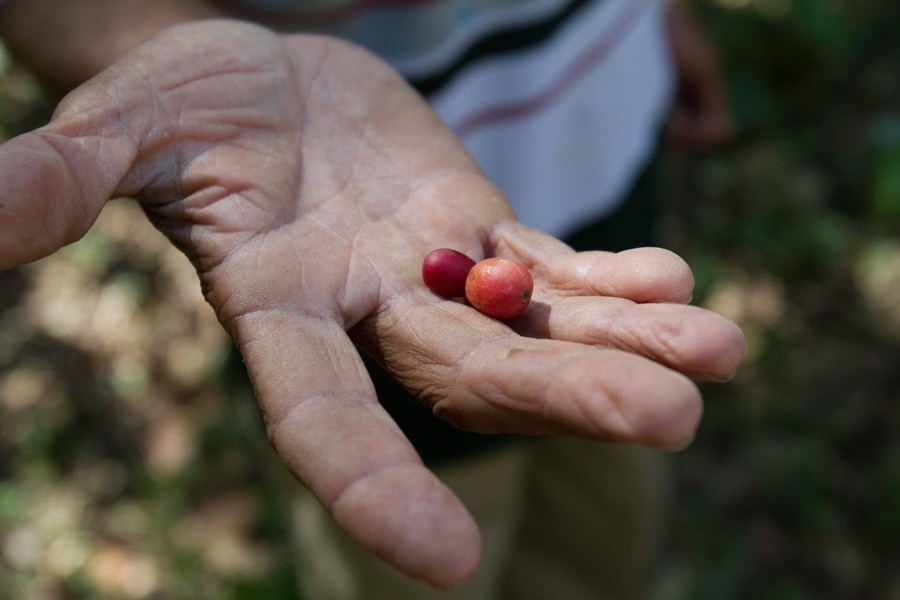Coffee and Clothing: Two Ways to Diversify an Economy
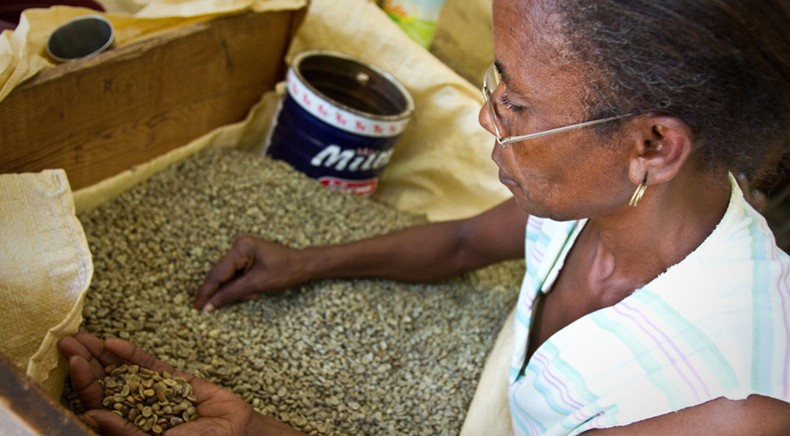
BY CRISTINA RAYAS
Cronkite Borderlands Initiative
VILLA ALTAGRACIA, Dominican Republic – An American clothing company is transforming lives and worker-employer relations here with a simple concept: paying a living wage.
And 13 miles to the west as the crow flies (but 57 miles in actual driving distance), family farmers in the steep, lush mountains near Los Cacaos are working together to produce pesticide-free, organic coffee, taking advantage of a growing niche market for coffee.
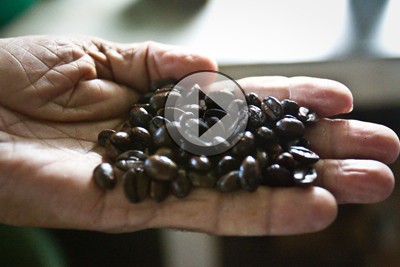 SLIDESHOW: Coffee, grown near the colorful town of Los Cacaos, is of increasing significance to the Dominican economy. |
In a country where the controversial sugar industry has long been king, the two companies are examples of the Dominican Republic’s attempts to diversify its economy.
More than half of the nation’s Gross Domestic Product – the value of goods and services –comes from the service industry, including tourism, trade, communications, real estate and other industries, according to the U.S. Department of State. Manufacturing accounts for 21.4 percent of the GDP and agriculture 7.7 percent.
The Dominican Republic is working hard to change those numbers by attracting foreign investors, like Knights Apparel, a privately owned company based in Spartanburg, S.C., and retraining and redirecting family farmers into new crops and new markets.
In Villa Altagracia, Knights Apparel is betting that when an American student pulls his logo-emblazoned school sweatshirt over his head, he’ll care about the workers who sewed the sleeves onto his favorite hoodie.
The company, which manufactures collegiate apparel, and its Dominican factory in Villa Altagracia, are competing for their place in college bookstores across the U.S. by asking students to shell out a few extra dollars to buy a sweatshirt that helped eliminate a sweatshop and gave workers rights they have never enjoyed before.
Knights Apparel has allowed its workers at the factory in Alta Gracia to advocate collectively – a rarity in a country where fewer than 10 percent of workers are unionized.
“One of the strategies that influences the lack of workers’ unions is the fact that a lot of times companies go to places that are very remote where people are not educated,” said Mariza Vargas, the secretary of the workers’ union, Sitralpro, as she sewed sleeves onto T-shirts. “And they take advantage of the fact that they are not educated enough to know their rights.”
But just the opposite happened at Alta Gracia. After taking over the manufacturing plant in 2007 from BJ&B, a South Korean-based company that sewed baseball caps for brands like Nike and Reebok, Knights Apparel raised workers wages ten-fold. The company pays its workers at Alta Gracia 4,432 pesos a week – about $120. That compares to the $12 a week paid to employees at BJ&B.
Moreover, workers had a strong say in what they would be paid. Vargas teamed up with the Worker Rights Consortium, an independent labor rights watchdog organization, to help determine a baseline living wage. They calculated the cost of food and water, housing and energy, clothing and health care, plus a modest savings, and determined that a living wage is 222,042 Dominican pesos a year, more than three times the local minimum wage. Knights Apparel agreed to pay the living wage.
Kayla Elisa Mena, 36, who used to work for BJ&B, said working for Knights Apparel –and earning the new, higher wage –has “change(d) my life 360 (degrees).” Before earning a living wage, she couldn’t keep up with her bills and shared a small house with many people, she said. Today she is paying off her debt and living in a more comfortable home.
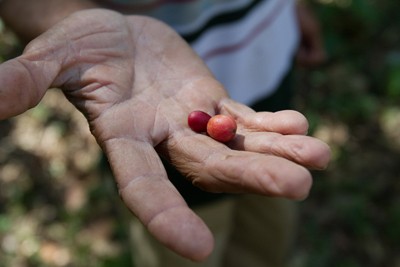
A worker displays organic coffee berries that were shade-grown on a mountainside in Los Cacaos, Dominican Republic. Photo by Michel Duarte |
Organic farming
Just a few miles away from the clothing plant in the mountains near Los Cacaos, family farmers who are members of the AGROESSA coffee cooperative also are inching their way toward economic stability.
To get to the La Esperanza Agroindustrial plantation, a rusty mini-bus, called a gua-gua (pronounced wah-wah) – makes an hour-long ascent, leaving the bustling streets of Los Cacaos behind. The endless greenery of trees is broken only to reveal the few tiny, derelict shacks that pepper the knolls. The idea of cell-phone reception is laughable as travelers take themselves off the grid, putting their lives in the hands of the gua-gua driver.
The coffee plantation is a relic of Dominican history but one with goals firmly fixed on the future: Organic, free-trade farming has reached these secluded peaks.
La Esperanza is a family-business; in fact, 961 families work the land and 200 of them contribute pesticide-free, certified organic coffee to the cooperative, said Juan Arias, the co-op president, who says he’s never heard of Starbucks, another reminder of just how far off the grid you are.
“We haven’t been able to expand (the number of certified organic farmers) much beyond that yet since it’s a costly process to get more farmers certified,” Arias said.
Over the past 25 years, agriculture has been reshaped in Latin America, fueled by new export opportunities for products like organic foods aimed at wealthy customers, particularly in the European Union.
From its small start in the 1980s, organic crops are now grown on more than 177,915 acres in the Dominican Republic. That represented 8.3 percent of the country’s agricultural acreage in 2009, according to the Switzerland-based Research Institute of Organic Agriculture, and it’s among the highest percentage of agricultural land devoted to organic farming in Latin America and the Caribbean.
Today, the major organic exports in the Dominican Republic are bananas, cocoa, coffee and mangos, accounting for a small but growing .13 percent of the GDP. Interestingly, the former king of cash crops, sugar, has not become a major organic export.
Haitian workers
Sugar, still an important crop, is intertwined with Dominican history. Christopher Columbus transported sugar cane to what is now the Dominican Republic in 1493. The industry flourished through the centuries, dependent on the labor of slaves and, later, on migrant Haitian sugar cane cutters.
The industry came under international scrutiny and condemnation in 1990 when international humanitarian groups charged that Haitian workers were being held in near slavery. The criticism prompted mass deportations of Haitian cane cutters in 1991.
Bernardo Vega, a former Dominican ambassador to the United States and a prominent economist and historian, said sugar mill owners long were the primary beneficiaries of Haitian labor. He said U.S. Marines occupying Haiti and the Dominican Republic in 1916 first promoted the idea of using Haitian workers.
“That was in the past,” Vega said. “Now the people who benefit from Haitian migrants are not only sugar producers. Only about 20 percent of Haitian migrants work in sugar.”
He said producers of coffee, bananas, cocoa and the construction sector are all dependent on Haitian labor, much of it undocumented, even though the country’s labor laws require that 80 percent of those jobs go to Dominicans.
No one has ever been taken to court for violating the laws, Vega said, and he doesn’t expect that to change. There are “so many vested interests which now make a lot of money on cheap Haitian labor,” he said. “And the labor unions who should be logical protestors have been politically weak.”
Arias estimated that only 10 of the 961 families in the co-op are of Haitian descent. But he acknowledged a seasonal dependence on Haitian workers and said immigration officials have come to his lands and chased Haitian workers down to deport them.
“Some come back and some don’t,” he said.
While giving a tour of the coffee fields, co-op member and farmer Italio Herrera also admitted that Haitians provide much of the labor at harvest time. Many live in bateyes, ramshackle company towns close to the fields – places frequently raided by immigration officials, who catch and deport illegal workers as they return from a day of work in the fields.
Using seasonal Haitian workers presents other challenges, Arias said. Many don’t understand sustainable farming and have to be trained. And because the workforce is so transient, there are always new workers who must be taught.
“It’s a workforce that comes with a lot of deficiencies,” Arias said.
The temporary workers tend to live apart from the more permanent community, he said.
“The community does not see them in social activities or social events,” he said. “They don’t integrate and that brings problems; because the cultures are so different, they clash.”
People and money
At the Knights Apparel plant in Villa Altagracia, such problems have been avoided because the factory hires only people with cedulas, national identification cards, said Mena, the employee who credits the plant with turning around her life.
“If you are Haitian with papers, you are hired. If you are Haitian without documents, you are not,” she said.
Mena said there are many undocumented Haitians living in her village who are limited to working as street vendors or for cash under the table. She wishes they could have dignified jobs, “but we have laws in this country,” she said.
Rudy Rijo, an administrative manager at the Knights Apparel plant, said there is no shortage of people seeking work at his plant, which currently employs 133.
“With labor, we have a lot of people available, a lot of qualified people. A lot of them need jobs, like these kinds of jobs,” Rijo said.
In fact, “excellent human resources” is one of the pitches that President Leonel Fernandez employs to attract foreign investment to the Dominican Republic.
Another is “attractive government incentives” – and indeed they are available. During his first stint in office in 1996, Fernandez signed a law giving foreign investors huge tax advantages for bringing their businesses to the island. The law created “free trade zones” for textiles and wearing apparel, for example, allowing manufacturers to import materials duty free to assemble . Other incentives keep taxes on foreign companies low. Alta Gracia is in one of these free trade zones.
The incentives have worked, increasing foreign investment in the country from $932 million in 2000 to a peak of nearly $3 billion in 2008, according to the Economic Commission for Latin America and the Caribbean of the United Nations.
Still, the plant at Altagracia and the plantation in Los Cacaos have faced formidable challenges in their quests to compete in the global market.
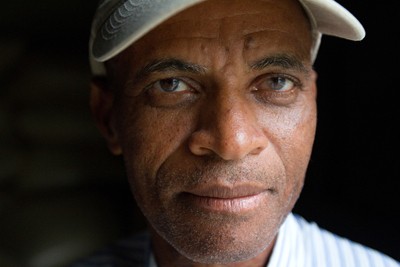
Juan Arias is president of the AGROESSA coffee cooperative. Photo by Michel Duarte |
Challenges for Coffee
Los Cacaos has been trying to integrate eco-tourism into its business model, hoping that tourists will come to see where their coffee comes from.
“The more tourists we have, the more they try our tasty product, and you know, that increases the outlet to get our product out,” Arias said.
The co-op was starting to build tourist housing and plan small-scale attractions, but progress was halted with the flooding that followed Hurricane Thomas in 2010. The community had to turn its attention to rebuilding homes and schools before starting on tourism ventures.
Natural disasters can create work shortages as well, Arias said. In 2007, a tropical storm devastated Los Cacaos, and instead of rebuilding, some families and workers moved to the cities to seek work.
“That’s hard because if they cannot make money here, they have to go and find a way to make money. But that means things are left here unattended,” he said.
Even in good times, organic farmers struggle with a difficult and expensive certification process for organic goods and detailed record-keeping requirements, he added.
AGROESSA has been helped by organizations such as the Peace Corps and a global fair trade movement. Today, Arias’ coffee is distributed to the United States and throughout Europe under the label “Café La Esperanza.”
New Clothing Market
At the Knights Apparel plant, things are even more uncertain. The market is not as well established and no one knows if the new plant is sustainable.
Business is down this year, said Rijo and administrative manager Adriana Tavernas, because a number of American university bookstores have not renewed their contracts.
“I think when we started everyone was really attracted to the idea of helping this community, but now they are not,” Tavernas said.
The company and its union are working hard to promote its clothing through online videos and conferences with students. The message, said union leader Vargas is that “we have the best customers: university students who respect and understand workers’ rights and understand how important freedom of association is.”
Workers and managers alike hope the message will resonate with the socially conscious, who will then pay a small premium to support a new way of business for Dominicans.
“It’s a long way from where we need to be,” Tavernas said. “But it has to start somewhere.”

